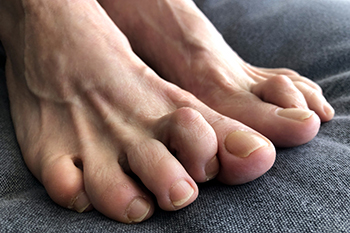Items filtered by date: December 2021
Arthritis Can Cause Pain in the Feet and Ankles
Differences between Hammer Toes, Claw Toes, and Mallet Toes
 Hammertoes, claw toes, and mallet toes all result from the toes getting bent into odd positions. They usually look odd or unsightly, and they typically affect the smaller toes. When the toe is bent downward and the middle joint raises up, this is known as a hammertoe. This condition frequently affects the second toe and sometimes coincides with a bunion. Claw toes occur when the toes curl up due to the middle joints being bent down, and they often affect all four smaller toes at the same time. When the joint closest to the tip of the toe bends downward, it forms what is known as a mallet toe. Wearing shoes that are too tight is most commonly blamed for these conditions arising, but they can also be linked to diabetes or arthritis. These toe ailments can be quite painful, so patients who are struggling with one would be wise to consult with a podiatrist who can help find a treatment option and determine if surgery is necessary.
Hammertoes, claw toes, and mallet toes all result from the toes getting bent into odd positions. They usually look odd or unsightly, and they typically affect the smaller toes. When the toe is bent downward and the middle joint raises up, this is known as a hammertoe. This condition frequently affects the second toe and sometimes coincides with a bunion. Claw toes occur when the toes curl up due to the middle joints being bent down, and they often affect all four smaller toes at the same time. When the joint closest to the tip of the toe bends downward, it forms what is known as a mallet toe. Wearing shoes that are too tight is most commonly blamed for these conditions arising, but they can also be linked to diabetes or arthritis. These toe ailments can be quite painful, so patients who are struggling with one would be wise to consult with a podiatrist who can help find a treatment option and determine if surgery is necessary.
Hammertoe
Hammertoes can be a painful condition to live with. For more information, contact one of our podiatrists from Sayville Foot Care. Our doctors will answer any of your foot- and ankle-related questions.
Hammertoe is a foot deformity that affects the joints of the second, third, fourth, or fifth toes of your feet. It is a painful foot condition in which these toes curl and arch up, which can often lead to pain when wearing footwear.
Symptoms
- Pain in the affected toes
- Development of corns or calluses due to friction
- Inflammation
- Redness
- Contracture of the toes
Causes
Genetics – People who are genetically predisposed to hammertoe are often more susceptible
Arthritis – Because arthritis affects the joints in your toes, further deformities stemming from arthritis can occur
Trauma – Direct trauma to the toes could potentially lead to hammertoe
Ill-fitting shoes – Undue pressure on the front of the toes from ill-fitting shoes can potentially lead to the development of hammertoe
Treatment
Orthotics – Custom made inserts can be used to help relieve pressure placed on the toes and therefore relieve some of the pain associated with it
Medications – Oral medications such as anti-inflammatories or NSAIDs could be used to treat the pain and inflammation hammertoes causes. Injections of corticosteroids are also sometimes used
Surgery – In more severe cases where the hammertoes have become more rigid, foot surgery is a potential option
If you have any questions please contact our office located in Sayville, NY . We offer the newest diagnostic and treatment technologies for all your foot and ankle needs.
Risk Factors for Ankle Sprains and Strains
The ankles are incredible joints that allow us to move our feet. Unfortunately, these joints are frequently the site of sprains or strains. An ankle sprain is rather common and occurs when a ligament in the ankle is overstretched or torn. A strain is not as frequent, and they develop when one of the muscles or tendons in the ankle become overstretched or torn. Certain factors can increase one’s risk of sustaining an ankle sprain or strain. These may include exercising with poor athletic conditioning, not warming up or stretching properly prior to beginning or ending a new activity, continuing to exercise despite muscle and ligament fatigue, carrying excess weight, and wearing non-supportive or ill-fitting shoes. If you are experiencing any type of ankle pain, please seek the care of a podiatrist as soon as possible.
Ankle pain can be caused by a number of problems and may be potentially serious. If you have ankle pain, consult with one of our podiatrists from Sayville Foot Care. Our doctors will assess your condition and provide you with quality foot and ankle treatment.
Ankle pain is any condition that causes pain in the ankle. Due to the fact that the ankle consists of tendons, muscles, bones, and ligaments, ankle pain can come from a number of different conditions.
Causes
The most common causes of ankle pain include:
- Types of arthritis (rheumatoid, osteoarthritis, and gout)
- Ankle sprains
- Broken ankles
- Achilles tendinitis
- Achilles tendon rupture
- Stress fractures
- Bursitis
- Tarsal tunnel syndrome
- Plantar fasciitis
Symptoms
Symptoms of ankle injury vary based upon the condition. Pain may include general pain and discomfort, swelling, aching, redness, bruising, burning or stabbing sensations, and/or loss of sensation.
Diagnosis
Due to the wide variety of potential causes of ankle pain, podiatrists will utilize a number of different methods to properly diagnose ankle pain. This can include asking for personal and family medical histories and of any recent injuries. Further diagnosis may include sensation tests, a physical examination, and potentially x-rays or other imaging tests.
Treatment
Just as the range of causes varies widely, so do treatments. Some more common treatments are rest, ice packs, keeping pressure off the foot, orthotics and braces, medication for inflammation and pain, and surgery.
If you have any questions, please feel free to contact our office located in Sayville, NY . We offer the newest diagnostic and treatment technologies for all your foot care needs.
What Can Cause a Stress Fracture?
Stress fractures in the feet are a common injury, particularly among athletes. They can be caused by any activity that puts increased pressure on the feet, from playing a high impact sport to starting a new workout routine. A sudden increase in activity, for example, running for much longer than usual, can overload the bones in your feet. Changing the surface that you train on can have a similar effect, specifically if you are moving from a soft surface, like turf, to a hard one like asphalt. Having an improper running technique or wearing the wrong shoes can also lead to stress fractures. If you are suffering from any type of foot pain, please seek the care of a podiatrist.
Stress fractures occur when there is a tiny crack within a bone. To learn more, contact one of our podiatrists from Sayville Foot Care. Our doctors can provide the care you need to keep you pain free and on your feet.
How Are They Caused?
Stress fractures are the result of repetitive force being placed on the bone. Since the lower leg and feet often carry most of the body’s weight, stress fractures are likely to occur in these areas. If you rush into a new exercise, you are more likely to develop a stress fracture since you are starting too much, too soon. Pain resulting from stress fractures may go unnoticed at first, however it may start to worsen over time.
Risk Factors
- Gender – They are more commonly found in women compared to men.
- Foot Problems – People with unusual arches in their feet are more likely to develop stress fractures.
- Certain Sports – Dancers, gymnasts, tennis players, runners, and basketball players are more likely to develop stress fractures.
- Lack of Nutrients – A lack of vitamin D and calcium may weaken the bones and make you more prone to stress fractures
- Weak Bones – Osteoporosis can weaken the bones therefore resulting in stress fractures
Stress fractures do not always heal properly, so it is important that you seek help from a podiatrist if you suspect you may have one. Ignoring your stress fracture may cause it to worsen, and you may develop chronic pain as well as additional fractures.
If you have any questions, please feel free to contact our office located in Sayville, NY . We offer the newest diagnostic and treatment technologies for all your foot care needs.
Foot Exercises for Arthritis
If you suffer from arthritis in your feet and ankles, doing gentle foot exercises regularly can help reduce or prevent symptoms like joint stiffness and pain. You can stretch your calves by placing a book on the floor and standing on it with just the balls of your feet, leaving your heels on the floor. Keep your knees straight and lean forward until you feel a stretch in your calves. Hold the stretch for 15 to 30 seconds. Exercise your ankles by sitting in a chair and lifting your foot slightly off the ground. Trace the letters of the alphabet in the air. Repeat on the other foot. For more helpful foot and ankle stretches, please consult with a podiatrist.
Because RA affects more than just your joints, including the joints in your feet and ankles, it is important to seek early diagnosis from your podiatrist if you feel like the pain in your feet might be caused by RA. For more information, contact one of our podiatrists of Sayville Foot Care. Our doctors will assist you with all of your podiatric concerns.
What Is Rheumatoid Arthritis?
Rheumatoid Arthritis (RA) is an autoimmune disorder in which the body’s own immune system attacks the membranes surrounding the joints. Inflammation of the lining and eventually the destruction of the joint’s cartilage and bone occur, causing severe pain and immobility.
Rheumatoid Arthritis of the Feet
Although RA usually attacks multiple bones and joints throughout the entire body, almost 90 percent of cases result in pain in the foot or ankle area.
Symptoms
- Swelling and pain in the feet
- Stiffness in the feet
- Pain on the ball or sole of feet
- Joint shift and deformation
Diagnosis
Quick diagnosis of RA in the feet is important so that the podiatrist can treat the area effectively. Your doctor will ask you about your medical history, occupation, and lifestyle to determine the origin of the condition. Rheumatoid Factor tests help to determine if someone is affected by the disease.
If you have any questions please feel free to contact our office located in Sayville, NY . We offer the newest diagnostic and treatment technologies for all your foot and ankle needs.




